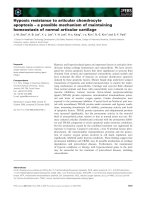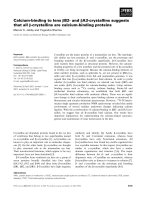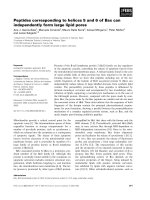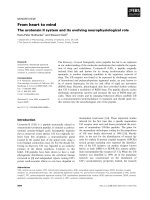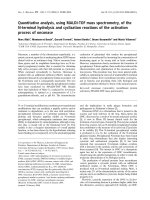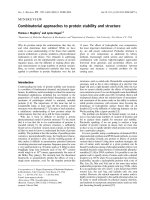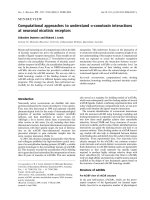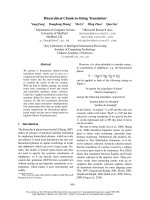báo cáo khoa học: "Hypersensitivity reactions to anticancer agents: Data mining of the public version of the FDA adverse event reporting system, AERS" ppsx
Bạn đang xem bản rút gọn của tài liệu. Xem và tải ngay bản đầy đủ của tài liệu tại đây (240.07 KB, 6 trang )
RESEARCH Open Access
Hypersensitivity reactions to anticancer agents:
Data mining of the public version of the FDA
adverse event reporting system, AERS
Kaori Kadoyama
1
, Akiko Kuwahara
2
, Motohiro Yamamori
2
, JB Brown
1
, Toshiyuki Sakaeda
1*
and Yasushi Okuno
1,3*
Abstract
Background: Previously, adverse event reports (AERs) submitted to the US Food and Drug Administration (FDA)
database were revie wed to confirm platinum agent-associated hypersensitivity reactions. The present study was
performed to confirm whether the database could suggest the hypersensitivity reactions caused by anticancer
agents, paclitaxel, docetaxel, procarbazine, asparaginase, teniposide, and etoposide.
Methods: After a revision of arbitrary drug names and the deletion of duplicated submissions, AERs involving
candidate agents were analyzed. The National Cancer In stitute Common Terminology Criteria for Adverse Events
version 4.0 was applied to evaluate the susceptibility to hypersensitivity reactions, and standardized official
pharmacovigilance tools were used for quantitative detection of signals, i.e., drug-associated adverse events,
including the proportional reporting ratio, the reporting odds ratio, the information component given by a
Bayesian confidence propagation neural network, and the empirical Bayes geometric mean.
Results: Based on 1,644,220 AERs from 2004 to 2009, the signals were detected for paclitaxel-associated mild,
severe, and lethal hypersensitivity reactions, and docetaxel-associated lethal reactions. However, the total number
of adverse events occurring with procarbazine, asparaginase, teniposide, or etoposide was not large enough to
detect signals.
Conclusions: The FDA’s adverse event reporting system, AERS, and the data mining methods used herein are
useful for confirming drug-associated adverse events, but the number of co-occurrences is an important factor in
signal detection.
Background
Hypersensitivity reactions (HSRs), though rare in
response to anticancer agents, are caused by certain
classes of agents including platinum agents (cisplatin,
carboplatin, and oxaliplatin), taxanes (paclitaxel and
docetaxel), procarbazine and asparaginase, and epipodo -
phyllotoxins (teniposide and etoposide) [1-5]. Despite
comparatively lower frequency, doxorubicin and 6-mer-
captopurine are also recognized as infrequent contribu-
tors to HSRs, and additionally other agents, e.g., 5-
fluorouracil, cyclophosphamide and cytarabine, are
thought to be agents that can potentially result in HSRs
[1,3]. The use of the term “hypersensitivity” is widely
used in cl inical reports, though its use is also sporadic,
and no exact definition is provided. It includes a wide
array of symptoms from mild flushing and itching to
lethal anaphylaxis. The pathogenic mechanisms by
which the reac tions occur are still unclea r, although
they seem to vary widely among agents. The exact pre-
valence of these reactions is difficult to evaluate, and
such a problems is hindering the establishment of
treatments.
Previously, pharmacoepidemiological studies have
been conducted to confirm that adverse events have
accompanied the use of cisplatin, carboplatin, and oxali-
platin [6,7]. More than a million case reports on adverse
events (AERs) submitted to the US Food and Drug
Administration (FDA) database were used, and a statisti-
cally significant association with an adverse event was
detected as a signal, by applying standardized official
* Correspondence: ;
1
Graduate School of Pharmaceutical Sciences, Kyoto University, Kyoto 606-
8501, Japan
Full list of author information is available at the end of the article
Kadoyama et al. Journal of Experimental & Clinical Cancer Research 2011, 30:93
/>© 2011 Kadoyama et al; licensee BioMed Central Ltd. This is an Open Access article distributed under the term s of the Creative
Commons Attribution License ( which permits unrestricted use, distribut ion, and
reproduction in any medium, provided the original work is properly cited.
pharmacovigilance methods [8-14]. This database relies
on reports of spontaneous adverse events to the FDA
generated by health professionals, consumers, and man-
ufacturers, and the system is referred to as the Adverse
Event Reporting System (AERS). These platinum agents
have been proven to cause nausea, vomiting, acute renal
failure, neutropenia, thrombocytopenia, and peripheral
sensory neuropathy [6]. In terms of susceptibility, their
rank-order was consistent with clinical observations,
suggesting the usefulness of the AERS database and the
data mining method used [6]. The National Cancer
Institute Common Terminology Criteria for Adverse
Events (NCI-CTCAE) version 4.0 was applied to evalu-
ate the susceptibility to hypersensitivity reactions, and
carboplatin and oxaliplatin were proved to cause mild,
severe, or lethal reactions [7]. However, the same analy-
tical method failed to detect signals for cisplatin-asso-
ciated reactions [7]. In the present study, AERs
submitted to the FDA were analyzed to detect signals
for HSRs caused by paclitaxel, docetaxel, procarbazine,
asparaginase, t eniposide, and etoposide, in order to
more clarify the critical factors to reproduce the clinical
observations on HSRs. Additionally, agents thought to
be associated with HSRs were also analyzed, including
doxorubicin, 6-mercaptopurine, 5-fluorouracil, cyclopho-
sphamide and cytarabine.
Methods
Data sources
Inputdataforthisstudyweretakenfromthepublic
release of the FDA’s AERS database, which covers the
period from the first quarter of 2004 through the end of
2009. The data structure of AERS is in compliance with
international safety reporting guidance, I CH E2B, con-
sisting of 7 data sets; patient demographic and admini s-
trative information (DEMO), drug/biologic information
(DRUG), adverse events (REAC), patient outcomes
(OUTC), report sources (RPSR), drug therapy start and
end dates (THER), and indications for use/diagnosis
(INDI). The adverse events in REAC are coded using
preferred terms (PTs) in the Medical Dictionary for Reg-
ulatory Activities (MedDRA) terminology.
Prior to analysis, all drug names were unified into
generic names by a text-mining approach, because
AERS permits the registering of arbitrary drug names,
including trade names and ab breviations. Spelling errors
were detected by GNU Aspell and carefully confirmed
by working pharmacists. Foods, beverages, treatments (e.
g. X-ray radiation), and unspecified names (e.g., beta-
blockers) were omitted for this study. Duplicated reports
were deleted according to FDA’s recommendation of
adopting the most recent CASE number, resulting in
the reduction of the number of AERs from 2,231,029 to
1,644,220. The primary and secondary suspected drugs
were subjected to investigation as well as concomitant
drugs.
Definition of adverse events
According to the NCI-CTCAE version 4.0, AERs with
PT10020751/hypersensitivity in REAC were a dopted as
the reports on mild HSRs, in which 19 lower level terms
(LLTs) were assigned in Me dDRA version13.0, including
LLT10000656/acute allergic reaction, LLT10001718/
allergi c reaction, LLT10020756/hypersensitivity reaction,
LLT10020759/hypersensi tivity symptom, LLT10038195/
red neck syndrome, and LLT100 46305/upper respiratory
tract hypersensitivity reaction (site unspecified). AERs
with PT10011906/death (with 13 LLTs) or death terms
in OUTC were excluded for mild HSRs. AERs with
PT10002198/anaphylactic reaction were adopted as the
reports on severe HSRs, in which 13 LLTs were
assigned, including LLT100 00663/acute anaphyla ctic
reaction and LLT10002218/anap hylaxis. AERs both with
PT10020751/hyper sensitivity, and with PT10011906/
death or death terms in OUTC were adopted as the
reports on lethal HSRs. Of note, LLT10001718/allergic
reaction and LLT10002218/anaphylaxis are also respec-
tively assigned as allergic reactions and anaphylaxis in
the NCI-CTCAE version 4.0, and PTs in their higher
levels were used in this study.
Data mining
In pharmacovigilance analysis, data mining algorithms
have been developed to identify drug-associated adverse
events as signals that are reported more frequently than
expected by estimating expected reporting frequencies
on the basis of information on all drugs and all events
in the database [12-14]. For example, the proportional
reporting ratio (PRR) [8], the reporting odds ratio
(ROR) [9], the information component (IC) [10], and
the empirical Bayes geometric mean (EBGM) [11] are
widely used, and indeed, the PRR is currently used by
the Medicines and Healthcare products Regulatory
Agency (MHRA), UK, the ROR by the Netherlands
Pharmacovigilance Centre, the IC by the World Health
Organization (WHO), and the EBGM by the FDA.
All of these algorithms extract decision rules for signal
detection and/or calculate scores to measure the asso-
ciations between drugs and adverse events from a two-
by-two frequency table of counts that involve the pre-
sence or absence of a particular drug and a particular
event occurring in case reports. These algo rith ms, how-
ever, differ from one another in that the PRR and ROR
are frequentist (non-Bayesian), whereas the IC and
EBGM are Bayesian. In this section, only the scoring
thresholds used in the present study are given, and the
reader is referred to review articles for more extensive
details of each statistical test [12-14].
Kadoyama et al. Journal of Experimental & Clinical Cancer Research 2011, 30:93
/>Page 2 of 6
Here,wedefinehowadrugandassociatedadverse
event is classified as a signal when using each stati stical
test. Using the PRR, a drug-event pair is classified as a
signal if the event count ≥ 3andthePRR≥ 2.0 with an
ass ociated c
2
value ≥ 4.0 [8]. Using the ROR, a signal is
detected if the lower bound of the 95% two-sided confi-
dence interval (CI) exceeds 1 [9]. Signa l det ection using
theICisdoneusingtheIC025metric,acriterionindi-
cating the lower bound of the 95% two-sided CI of the
IC, and a signal is det ected with the IC025 val ue
exceeds 0 [10]. Finally, the EB05 metric, a lower one-
sided 95% confidence limit of EBGM [11], is used and a
signal is detected when EB05 is greater than or equal to
the threshold value 2.0.
Results
Table 1 lists the total number of adverse events occur-
ring with each anticancer agent we investigated, and
therein the numbers of co-occurrences with mild, severe
or lethal HSRs. The total number of adverse events was
less than 10,000 for procarbazine, asparaginase, tenipo-
side, and 6-mercaptopurine, and those occurring with
HSRs did not exceed 30 in total per agent. For etoposide
and cytarabine, about 30,000 adverse events were found
in total, but the number of HSRs co-occurrences
counted was only about 50.
The statistical data on 5 other agents, paclitaxel, doce-
taxel, doxorubicin, 5-fluorouraci l, and cyclophospamid e,
are summarized in Tables 2, 3 and 4. As shown i n
Table 2, the signals were detected for paclitaxel- and 5-
fluorouracil-associated mild HSRs with 228 and 108 co-
occurrences, respectively, but the association was only
marginal for the latter. No signals were detected for
docetaxel, doxorubicin, and cyclophospamide. As for
severe reaction, the signal was detected for paclitaxel,
but no signals for other four (Table 3). The associations
with lethal rea ctions were detected for paclitaxel, doce-
taxel and 5-fluorouracil (Table 4).
Discussion
The AERS databa se covers several million case reports
on adverse events. Pharmacovigilance analysis aims to
search for previously unknown patterns and automati-
cally detect important signals, i.e., drug-associated
adverse events, from such a large database. Recently
developed data mining tools for pharmacovigilance have
been successful at detecting signals that could not be
found by individual case r eviews and that warrant
further investigation together with continuous surveil-
lance. For this reason, data mining tools are being routi-
nely used for pharmacovigilance, supporting signal
detection and decision-making at companies, regulatory
agencies, and pharmacovig ilance centers [8-14]. Despite
some limitations inherent to spontaneo us reporting, the
AERSdatabaseisarichresourceandthedatamining
tools provide a powerful means of identifying potential
associations between drugs and adverse events.
Although HSRs are considered uncommon during
treatment with a nticancer agents, platinum agents, tax-
anes, procarbazine, asparaginase, and epipodophyllotox-
ins are thought to increase the susceptibility to such
reactions [1-5]. Previously [7], and in this study, phar-
macoepidemiological analyses were performed to con-
firm the HSRs caused by these agents, using more than
a million AERs submitted to the FDA. The NCI-CTCAE
version 4.0 was applied to evaluate the susceptibility to
HSRs. Carboplatin, oxaliplatin, and paclitaxel were sta-
tistically demonstrated to be associated with mild,
severe, and lethal HSRs, and docetaxel was associated
with lethal reactions. No signals were detected for cis-
platin, procarbazine, asparaginase, teniposide, and etopo-
side. For these latter agents, the total number of co-
occurrences with HSRs was less than 100. Although the
application of the NCI-CTCAE version 4.0 might have
the effect on reproducibility of clinical observations, the
total number of adverse events occurring with each
ant icancer agent we investigated and the number of co-
occurrences of HSRs would be important factors.
In this study, we tried to evaluate the demographic
effect on the susceptibility to severe HSRs. The ratio of
male/female/unknown was 22/49/8 for the patients with
paclitaxel-related severe HSR and the average value of
age was 57.4 ± 15.0 years. These values were not differ-
ent from those for all AERs. Similarly to paclitaxel, we
could not figure out the effects of gender or age, in t he
cases of docetaxel and 5-fluorouracil. Additionally, the
total number of drugs co-administered with 5-fluoroura-
cil was 211 in 44 co-occurrences, and 29 of 211 was
oxaliplatin, which is a well-established cause of HSRs.
Table 1 The number of adverse events occurring with
each anticancer agent
N
a)
Mild
b)
Severe
b)
Lethal
b)
paclitaxel 42,038 228 * 79 * 12 *
docetaxel 36,983 79 18 17 *
procarbazine 1,287 1 0 0
asparaginase 6,414 1 5 2
teniposide 151 1 0 0
etoposide 28,264 31 25 3
doxorubicin 47,834 101 41 9
6-mercaptopurine 9,170 17 13 0
5-fluorouracil 40,282 108 * 44 10 *
cyclophosphamide 70,728 110 51 9
cytarabine 31,765 20 24 3
a) the total number of adverse events occurring with each anticancer agent.
b) the number of co-occurrences of mild, severe and lethal hypersensitivity
reactions.
*: A signal was detected by at least 1 of 4 statistical indices
Kadoyama et al. Journal of Experimental & Clinical Cancer Research 2011, 30:93
/>Page 3 of 6
The co-administration drugs a lso can be confounding
factor, and further analysis should be done w ith much
larger numbers of co-occurrences.
Taxanes show poor water solubility, and are formu-
lated with low molecular weight surfactants, for exam-
ple, Cremophor EL and Tween 80 (polysorbate 80).
These surfactants might contribute to HSRs. Although it
is still controversial whether the surfactants or taxane
moiety is responsible for HSRs [3,4,15-17], the differ-
ence between paclitaxel and docetaxel with regard to
susceptibility might be explained by the surfactants
[3,4]. Recently, surfactant-free novel derivatives and for-
mulations have been developed. Their safety profiles will
shed light on the debate about taxane-associated HSRs.
5-Fluorouracil, generally, is considered to be rarely
associated with HSRs, although there are scattered
reports of anaphylactic reactions occurring during or
after its intravenous administration [18-21]. However, in
this analysis, signals were detected for mild and lethal
HSRs, and the susceptibility was comparable with that
of docetaxel (Tables 2 and 4). This m ight be explained
by co-administered oxaliplatin as stated. 5-Fluorouracil
is used for cutaneous diseases such as psoriasis and acti-
nic keratoses, and an irritant contact dermatitis is fre-
quently seen [22-25]. This might be counted as
hypersensitivity. Furthermore, hand-foot syndrome, a
major adverse event of 5-fluorouracil, is cha racterized
by painful erythematous lesions which mainly affect pal-
moplantar surfaces [26-28]. This syndrome might affect
to analysis, because professionals could easily recognize
symptoms involving sweat-associated toxicity, which is
not a HSR, yet non-professionals might be mislead to
classify the symptom as a HSR.
Conclusions
AERs submitted to the FDA were analyzed using statis-
tical techniques to establish the anticancer agent-asso-
ciated HSRs. Based on 1,644,220 AERs from 2004 to
2009, the signals were detected for paclitaxel-associated
mild, severe, and lethal HSRs, and docetaxel-associated
Table 2 Signal detection for anticancer agent-associated mild hypersensitivity reactions
N PRR (c2) ROR (95% two-sided CI) IC (95% two-sided CI) EBGM (95% one-sided CI)
paclitaxel 228 2.768 * (254.855) 2.788 * (2.438, 3.117) 1.450 * (1.262, 1.638) 2.707 * (2.425)
docetaxel 79 1.087 (0.463) 1.087 (0.871, 1.302) 0.109 (-0.209, 0.427) 1.073 (0.890)
doxorubicin 101 1.074 (0.445) 1.074 (0.884, 1.265) 0.095 (-0.187, 0.376) 1.064 (0.902)
5-fluorouracil 108 1.365 (10.154) 1.366 * (1.130, 1.601) 0.436 * (0.164, 0.708) 1.344 (1.145)
cyclophosphamide 110 0.791 (5.894) 0.790 (0.655, 0.925) -0.342 (-0.612, -0.073) 0.788 (0.673)
The total number of co-occurrences with mild hypersensitivity reactions was 43,288.
N: the number of co-occurrences of each anticancer agent out of 43,288 pairs, PRR: the proportional reporting ratio, ROR: the reporting odds ratio, IC: the
information component, EBGM: the empirical Bayes geometric mean.
*: signal detected, see “Methods” for the detection criteria.
Table 3 Signal detection for anticancer agent-associated severe hypersensitivity reactions
N PRR (c2) ROR (95% two-sided CI) IC (95% two-sided CI) EBGM (95% one-sided CI)
paclitaxel 79 2.273 * (55.041) 2.278 * (1.826, 2.730) 1.151 * (0.833, 1.469) 2.174 (1.803)
docetaxel 18 0.588 (4.805) 0.587 (0.370, 0.805) -0.773 (-1.431, -0.115) 0.591 (0.401)
doxorubicin 41 1.036 (0.021) 1.036 (0.762, 1.309) 0.032 (-0.408, 0.471) 1.014 (0.782)
5-fluorouracil 44 1.320 (3.102) 1.321 (0.982, 1.659) 0.374 (-0.051, 0.799) 1.276 (0.994)
cyclophosphamide 51 0.871 (0.851) 0.871 (0.661, 1.080) -0.209 (-0.604, 0.185) 0.862 (0.683)
The total number of co-occurrences with severe hypersensitivity reactions was 18,255.
N: the number of co-occurrences of each anticancer agent out of 18,255 pairs, PRR: the proportional reporting ratio, ROR: the reporting odds ratio, IC: the
information component, EBGM: the empirical Bayes geometric mean.
*: signal detected, see “Methods” for the detection criteria.
Kadoyama et al. Journal of Experimental & Clinical Cancer Research 2011, 30:93
/>Page 4 of 6
lethal reactions. However, the total number of adverse
events occurring with procarbazine, asparaginase, teni-
poside, or etoposide was not large enough to detect sig-
nals. The database and the data mining methods used
herein are useful, but the number of co-occurrences is
an important factor in signal detection.
Acknowledgements
This work was supported in part by Funding Program for Next Generation
World-Leading Researchers and a Grant-in-Aid for Scientific Research from
the Ministry of Educat ion, Culture, Sports, Science and Technology of Japan.
Author details
1
Graduate School of Pharmaceutical Sciences, Kyoto University, Kyoto 606-
8501, Japan.
2
School of Pharmacy and Pharmaceutical Sciences, Mukogawa
Women’s University, Nishinomiya 663-8179, Japan.
3
Kyoto Constella
Technologies Co Ltd., Kyoto 604-8156, Japan.
Authors’ contributions
KK, AK, MY, and TS made conception, designed and coordinated the study.
YO and JB carried out calculations and statistical analysis. KK, JB and TS
prepared the manuscript. All authors read and approved the final
manuscript.
Competing interests
The author declares that they have no competing interests.
Received: 8 August 2011 Accepted: 5 October 2011
Published: 5 October 2011
References
1. Pagani M: The complex clinical picture of presumably allergic side
effects to cytostatic drugs: symptoms, pathomechanism, reexposure,
and desensitization. Med Clin North Am 2010, 94:835-852.
2. Syrigou E, Syrigos K, Saif MW: Hypersensitivity reactions to oxaliplatin and
other antineoplastic agents. Curr Allergy Asthma Rep 2008, 8:56-62.
3. Shepherd GM: Hypersensitivity reactions to chemotherapeutic drugs. Clin
Rev Allergy Immunol 2003, 24:253-262.
4. Lee C, Gianos M, Klaustermeyer WB: Diagnosis and management of
hypersensitivity reactions related to common cancer chemotherapy
agents. Ann Allergy Asthma Immunol 2009, 102:179-187.
5. Lenz HJ: Management and preparedness for infusion and
hypersensitivity reactions. Oncologist 2007, 12:601-609.
6. Sakaeda T, Kadoyama K, Okuno Y: Adverse event profiles of platinum
agents: Data mining of the public version of the FDA adverse event
reporting system, AERS, and reproducibility of clinical observations. Int J
Med Sci 2011, 8:487-491.
7. Sakaeda T, Kadoyama K, Yabuuchi H, Niijima S, Seki K, Shiraishi Y, Okuno Y:
Platinum agent-induced hypersensitivity reactions: Data mining of the
public version of the FDA adverse event reporting system, AERS. Int J
Med Sci 2011, 8:332-338.
8. Evans SJ, Waller PC, Davis S: Use of proportional reporting ratios (PRRs)
for signal generation from spontaneous adverse drug reaction reports.
Pharmacoepidemiol Drug Saf 2001, 10:483-486.
9. van Puijenbroek EP, Bate A, Leufkens HG, Lindquist M, Orre R, Egberts AC: A
comparison of measures of disproportionality for signal detection in
spontaneous reporting systems for adverse drug reactions.
Pharmacoepidemiol Drug Saf 2002, 11:3-10.
10. Bate A, Lindquist M, Edwards IR, Olsson S, Orre R, Lansner A, De Freitas RM:
A Bayesian neural network method for adverse drug reaction signal
generation. Eur J Clin Pharmacol 1998, 54:315-321.
11. Szarfman A, Machado SG, O’Neill RT: Use of screening algorithms and
computer systems to efficiently signal higher-than-expected
combinations of drugs and events in the US FDA’s spontaneous reports
database. Drug Saf 2002, 25:381-392.
12. Bate A, Evans SJ: Quantitative signal detection using spontaneous ADR
reporting. Pharmacoepidemiol Drug Saf 2009, 18:427-436.
13. Gould AL: Practical pharmacovigilance analysis strategies.
Pharmacoepidemiol Drug Saf 2003, 12:559-574.
14. Almenoff JS, Pattishall EN, Gibbs TG, DuMouchel W, Evans SJ, Yuen N:
Novel statistical tools for monitoring the safety of marketed drugs. Clin
Pharmacol Ther 2007, 82:157-166.
15. Syrigou E, Dannos I, Kotteas E, Makrilia N, Tourkantonis I, Dilana K, Gkiozos I,
Saif
MW, Syrigos KN: Hypersensitivity reactions to docetaxel:
Retrospective evaluation and development of a desensitization protocol.
Int Arch Allergy Immunol 2011, 156:320-324.
16. Szebeni J, Muggia FM, Alving CR: Complement activation by Cremophor
EL as a possible contributor to hypersensitivity to paclitaxel: an in vitro
study. J Natl Cancer Inst 1998, 90:300-306.
17. Szebeni J, Alving CR, Savay S, Barenholz Y, Priev A, Danino D, Talmon Y:
Formation of complement-activating particles in aqueous solutions of
Taxol: possible role in hypersensitivity reactions. Int Immunopharmacol
2001, 1:721-735.
18. Biswal BM: Anaphylaxis following continuous 5-fluorouracil infusion
chemotherapy. Aust N Z J Med 1999, 29:743-744.
19. Sridhar KS: Allergic reaction to 5-fluorouracil infusion. Cancer 1986,
58:862-864.
20. Eppinger T, Sperber K: Desensitization to 5-fluorouracil. Allergy Asthma
Proc 1999, 20:189-191.
21. Millá Santos A, Sanchiz Medina F: Anaphylactic reaction following i.v.
administration of 5-fluorouracil. Cancer Treat Rep 1986, 70:1346.
22. Meijer BU, de Waard-van der Spek FB: Allergic contact dermatitis because
of topical use of 5-fluorouracil (Efudix cream). Contact Dermatitis 2007,
57:58-60.
23. Epstein E: Does intermittent “pulse” topical 5-fluorouracil therapy allow
destruction of actinic keratoses without significant inflammation? JAm
Acad Dermatol 1998, 38:77-80.
Table 4 Signal detection for anticancer agent-associated lethal hypersensitivity reactions
N PRR (c2) ROR (95% two-sided CI) IC (95% two-sided CI) EBGM (95% one-sided CI)
paclitaxel 12 2.623 * (10.495) 2.631 * (1.492, 3.770) 1.165 * (0.363, 1.967) 1.992 (1.237)
docetaxel 17 4.224 * (38.715) 4.247 * (2.635, 5.858) 1.800 * (1.121, 2.478) 3.268 * (2.062)
doxorubicin 9 1.728 (2.086) 1.731 (0.900, 2.563) 0.614 (-0.305, 1.533) 1.401 (0.819)
5-fluorouracil 10 2.281 * (5.977) 2.286 * (1.228, 3.344) 0.964 * (0.089, 1.838) 1.735 (1.037)
cyclophosphamide 9 1.169 (0.083) 1.170 (0.608, 1.731) 0.127 (-0.792, 1.046) 1.047 (0.613)
The total number of co-occurrences with lethal hypersensitivity reactions was 2,397.
N: the number of co-occurrences of each anticancer agent out of 2,397 pairs, PRR: the proportional reporting ratio, ROR: the reporting odds ratio, IC: the
information component, EBGM: the empirical Bayes geometric mean.
*: signal detected, see “Methods” for the detection criteria.
Kadoyama et al. Journal of Experimental & Clinical Cancer Research 2011, 30:93
/>Page 5 of 6
24. Yesudian PD, King CM: Allergic contact dermatitis from stearyl alcohol in
Efudix cream. Contact Dermatitis 2001, 45:313-314.
25. Sánchez-Pérez J, Bartolomé B, del Río MJ, García-Díez A: Allergic contact
dermatitis from 5-fluorouracil with positive intradermal test and
doubtful patch test reactions. Contact Dermatitis 1999, 41:106-107.
26. Degen A, Alter M, Schenck F, Satzger I, Völker B, Kapp A, Gutzmer R: The
hand-foot-syndrome associated with medical tumor therapy -
classification and management. J Dtsch Dermatol Ges 2010, 8:652-661.
27. Yen-Revollo JL, Goldberg RM, McLeod HL: Can inhibiting
dihydropyrimidine dehydrogenase limit hand-foot syndrome caused by
fluoropyrimidines? Clin Cancer Res 2008, 14:8-13.
28. Chiara S, Nobile MT, Barzacchi C, Sanguineti O, Vincenti M, Di Somma C,
Meszaros P, Rosso R: Hand-foot syndrome induced by high-dose, short-
term, continuous 5-fluorouracil infusion. Eur J Cancer 1997, 33:967-969.
doi:10.1186/1756-9966-30-93
Cite this article as: Kadoyama et al.: Hypersensitivity reactions to
anticancer agents: Data mining of the public version of the FDA
adverse event reporting system, AERS. Journal of Experimental & Clinical
Cancer Research 2011 30:93.
Submit your next manuscript to BioMed Central
and take full advantage of:
• Convenient online submission
• Thorough peer review
• No space constraints or color figure charges
• Immediate publication on acceptance
• Inclusion in PubMed, CAS, Scopus and Google Scholar
• Research which is freely available for redistribution
Submit your manuscript at
www.biomedcentral.com/submit
Kadoyama et al. Journal of Experimental & Clinical Cancer Research 2011, 30:93
/>Page 6 of 6

